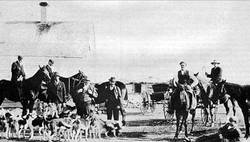Cricket matches, sometimes followed by a lawn social, were once quite common in Manitoba communities. Teams travelled some distance, lured by their love of the sport and the opportunity to socialize with others with this common interest. In the Turtle Mountain region, the “English Settlement”, would likely have organized such matches.
There were many attempts in Western Canada for groups from Britain to duplicate the sort of life they were used to in their home country. A few attained some national prominence, such as the Cannington Manor settlement near the Moose Mountains in Saskatchewan. Most eventually just blended in with their neighbours, but even these affected some lasting influence on their larger communities. That was the case with the substantial and influential group of English immigrants who settled in the Waubeesh area about ten kilometres west of Boissevain in the early 1880’s.
Many were recruited by Reverend Bridges, known as the “Emigrant Chaplain” of St. Nicholas Church, Liverpool, who organized settlement parties bound for Canada.

Lords of the Manor?
They brought with them cricket paddles rather than baseball bats. They preferred the waltz to the square dance. When wolves preyed upon their sheep they appointed a “Master of the Hounds” and set out to hunt, turning a practical enterprise into a social outing. Many named their houses, as was the fashion in Britain. My favorite example is “Bleak House”, the name Charles Hurt chose for his modest home. Here we get a glimpse of both their cultural heritage and a subtle display of humour; humour that might well have reflected a desire to make the practice less pretentious. Above all, it was a sly comment on the prairie conditions they faced.
Thus they provided a bit of cultural contrast to the region. References to the community pop up here and there in the local histories:
“Emma McGregor was a sister of Captain Hutton, a resident of the English settlement near Whitewater. She was born in India, her father in the Military services there. She was educated in painting and music, and a talented pianist, and wrote many musical compositions.“ Green Englishmen?
Mr. V. Udall remembers, “Harry Whiteside, Hugh Dusenbury and I arrived in Boissevain from the Isle of Man on March 31, 1890. We were greeted by the customary banter and tricks played upon "green Englishmen." This sort of banter, sometimes only half in jest, and often reflecting a sincerely-felt prejudice, happened across the prairies in the settlement times.
There was indeed a distinct separation between “Canadian” settlers and Englishmen. The Canadians, largely from Ontario, felt that they were already veterans in the pioneer business. Their families had cleared bush in Upper Canada and knew what winter was all about. They knew how to farm, and were supported by government promotional activities in the belief that the “West” was theirs for the taking. They belonged.
The Englishmen came directly from Britain, and were viewed as less practical than the Ontario group. They were sometimes viewed as snobs and greenhorns. Some did arrive full of a spirit of adventure, but woefully unprepared for the tough sledding, literally and otherwise. In fact there were instances of “Help Wanted” signs carrying a warning such as “No Englishmen”.
Remittance Men
One source of prejudice against the English settler might have stemmed from the British practice of sending wayward offspring off to the “colonies” with a stipend to get them out of the way. Indeed most communities had experience with some mildly disgraced younger son of a British landowner who had been sent to the Prairies, either in hopes of redemption, or simply to get him out of the way.
But the Waubeesh English settlement wasn’t made up of such “remittance men” and idle dreamers, and despite their determination to keep their “Englishness”, their neighbours soon realized that.
Yes, they did attend the Anglican Church while the Ontarians were Presbyterian or Methodist, and they were fans of John A. MacDonald and his Conservatives while the “Canadians” often brought with them a preference for “Presbyterian Grits” (Liberals). But those were personal matters.
When it came to working together to build a typical prairie settlement, they were on the same page.
. . . . .
Author: Ken Storie
Sources:
Boissevain History Book Committee. Beckoning Hills Revisited. “Ours is a Goodly Heritage” Morton – Boissevain 1881 – 1981. Altona. Friesen Printing, 1981 Winnipeg Daily Sun, 84.05.13 Berger, Carl. Review: Dunae, Patrick A. Gentlemen Emigrants From the British Public Schools to the Canadian Frontier. Manitoba History, Number 4, 1982Weighton, William. The Story of 100 Years of Cricket in Manitoba. Manitoba Pageant, Autumn 1974, Volume 20, Number 1 Photos:Ken Storie, 2014. Saskatchewan Archives Board: http://www.mhs.mb.ca/docs/mb_history/04/gentlemenemigrants.shtml
